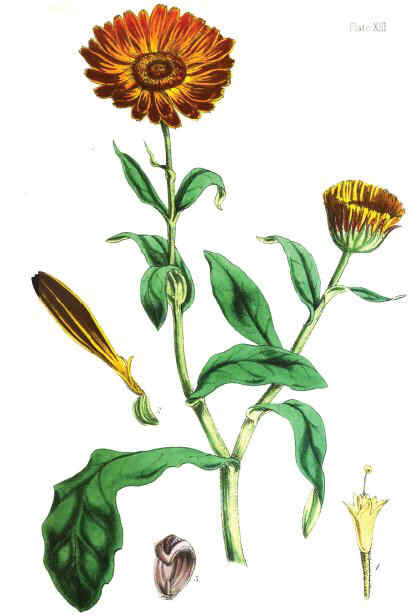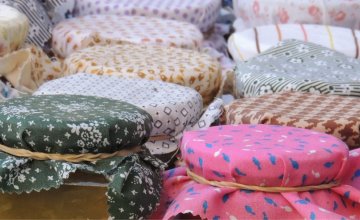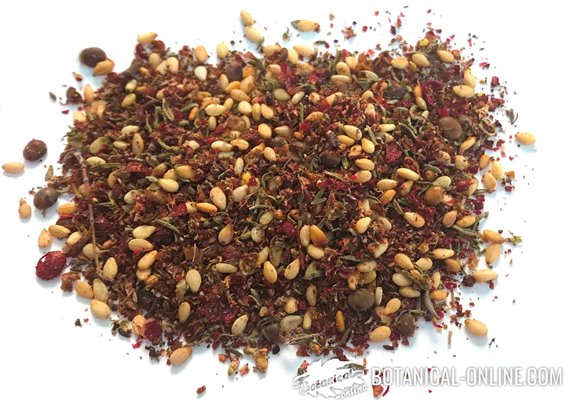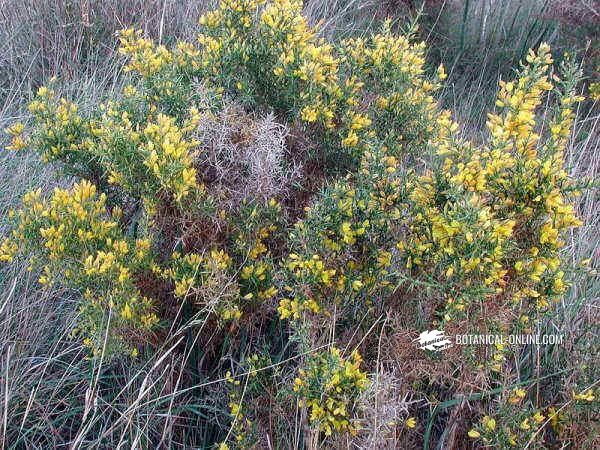Contents
- 1 Pinaceae properties
- 1.1 USES OF PINACEAE
- 1.2 Pinnaceae importance in gardening
- 1.3 Pinaceae as Christmas plants
- 1.4 PINACEAE IN THE INDUSTRY
- 1.5 For the production of tannins
- 1.6 For the production of resins and derivatives
- 1.7 Amber from pinaceae
- 1.8 Pinaceae as producers of essential oils
- 1.9 Pinaceae as a source of materials for crafts
- 1.10 PINACEAE AS FOOD PRODUCERS
- 1.11 Edible bark of Pinaceae
- 1.12 Edible seeds of pinaceae: pine nuts
- 1.13 PINACEAE AS FOLK REMEDIES
Pinaceae properties
USES OF PINACEAE
Some Pinaceae, such as mountain pine (Pinus mugo) or stone pine (Pinus pinea), are planted to fix dunes and protect the land from erosion.
The latter however is even more interesting for the production of edible seeds (pine nuts)
Pinnaceae importance in gardening
As ornamental trees, pine trees and alike provide great shade and beauty and can be planted in large gardens or parks. Many firs are planted with this intention, given its pyramidal shape that provides elegance.
Among these ornamental species we can mention some as well known as European silver fir (Abies alba), Korean fir (Abies koreana), white fir or Colorado (Abies concolor), giant fir (Abies grandis) or noble fir (Abies procera).
What to say about the majestic cedar of Lebanon (Cedrus libani) planted in the center of a large garden.
We must not forget that many conifers, especially Cupressaceae and Pinaceae, are used for bonsai technique. For example:
Pinus nigra, Pinus sylvestris, Pinus parviflora, Pinus pumila, Pinus ponderosa, Pinus rigida, Pinus strobus, Pinus flexilis, Picea abies, Picea glauca, Picea Mariana, Picea orientalis, Picea jezoensis, Larix decidua, Psesudolarix Kaempferi and Cedrus ssp.
Other Pinaceae provide a sample of color to the garden, such as blue-green Colorado blue spruce (Picea pungens) or the bright green of Monterey pine (Pinus radiata)
Some are used as material for the formation of hedges, such as Canadian hemlock (Tsuga canadensis)
The leaves of many conifers are used as mulch in gardening or horticulture.
Covering the soil with “pine straw” is specially used to maintain the degree of soil moisture, protect roots and hinder the birth of herbs.
This material is collected from under Pinaceae by machines. Among the main species used for the production of this resource, we have longleaf pine (Pinus palustris) and loblolly pine (Pinus taeda).
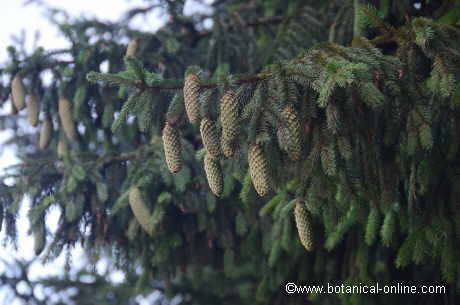
Pinaceae as Christmas plants
Fir trees are very popular as Christmas trees. In America one of the most used is the Abies balsamea, known popularly as Christmas fir or balsam fir.
In Europe, however, the European silver fir (Abies alba) is the most used, although, in recent years, people have been moving to the Norway spruce (Picea Abies).
Recently, and especially in the United States, some pine species are replacing traditional Christmas trees. Among the most used are Scots pine (Pinus sylvestris), Monterey pine (Pinus radiata) or mountain pine (Pinus mugo).
Crowns are among the Christmas items most widely used in the Anglo-Saxon world. Many of them are made with branches and leaves of pinaceae, especially, in the United States, the noble fir (Abies procera) and twisted pine (Pinus contorta)
Other crowns not focus exclusively on these holidays but are used for different purposes. Among the species used in Europe we have the European silver fir (Abies alba) as the most commonly used species.
PINACEAE IN THE INDUSTRY
Pinaceae are used in industry in the manufacture of different products:
For the production of tannins
Tannins are used in the leather industry and in the food industry – both, food and drinks industry – in paints, inks, etc.
Tannins for industry are obtained from several pine family tree barks, among which genera such as Quercus, Castanea or Pinaceae.
Within Pinaceae, the genus Tsuga is the most used and the most used species in America is Canadian hemlock (Tsuga canadensis), Western hemlock (Tsuga heterophylla) and Monterey pine (Pinus radiata). In Europe, Norway spruce (Picea abies) is the most used.
For the production of resins and derivatives
Within Pinaceae, pines are the most used in this sense. Pine oleoresins have traditionally been used as wood sealants and preservatives in the production of boats. In southern Europe Aleppo pine (Pinus halepensis) has been the most used, with Scots pine (Pinus sylvestris), the most widely used in northern Europe.
In America, the European colonization led the exploitation of pine forests for the production of resins from native species such as longleaf pine (Pinus palustris), Monterey pine (Pinus radiata) or slash pine (Pinus elliottii).
– Which pines are used to produce resins?
Resins can practically be obtained from any pines, but today people use those that commercially give more quality resins in sufficient amount.For this purpose pine trees growing in warm areas are chosen. In many cases, they have been planted in these places precisely for this purpose.
Among today’s most used species we have: Pinus brutia, Pinus caribaea, Pinus elliottii, Pinus halepensis, Pinus kesiya, Pinus massoniana, Pinus merkusii, Pinus oocarpa, Pinus pinaster, Pinus radiata, Pinus roxburghii, Pinus sylvestris.
Other producers are:
– Balsam fir (Abies balsamea) whose resin distillation produces Canada balsam to obtain turpentine of Canada.
– Norway spruce (Picea Abies) and other pines are used to produce galipot which is a type of resin obtained by spontaneous evaporation of essential oil of turpentine hardened on the bark of trees.
From the distillation of resins, essential oil of turpentine is obtained which has many applications in the chemical and pharmaceutical industry (paint thinner, composition of rubber, plastics, asphalt, inks, insecticides, etc.)
Rosin, colophony or Greek pitch is the solid residue which was dissolved in the essential oil of turpentine and left free after distillation. It has a brown or pale yellow, though it can even be transparent. Its applications are very large in the world of industry (chewing gum, soap, paper, paints, adhesives, industrial oils, linoleum, inks, etc.)
Amber from pinaceae
Amber is a fossil resin which can be found on the ground after a very long formation process.
It may come from different types of plants, both gymnosperms and angiosperms.
Within conifers the two families that stand out in amber production are Araucariaceae and Pinaceae.
Pinaceae as producers of essential oils
Conifers of the genus Cedrus, contain the most used trees in the production of essential oils, mainly used in aromatherapy and industry of soaps, perfumes, disinfectants, air fresheners, etc.
Among them, the most important are Atlas cedar (Cedrus atlantica) and Himalayan cedar (Cedrus deodara).
Other Pinaceae producing essential oils are: balsam fir (Abies balsamea) from which the essential oil of balsam fir is made; Siberian fir (Abies sibirica), from which the Siberian balsam oil is obtained; Scots pine (Pinus sylvestris) that produces Red pine oil or mountain pine (Pinus montana) used for the production of mountain pine oil.
Canadian hemlock (Tsuga canadensis) provides fir oil.
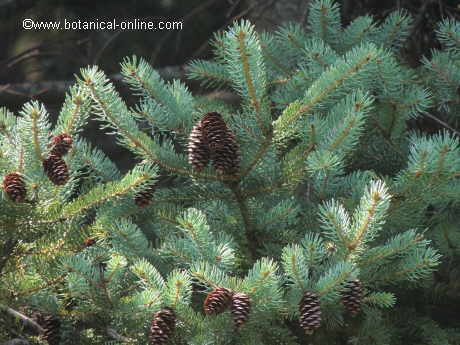
Pinaceae as a source of materials for crafts
Many primitive people have used the roots, leaves, branches or bark of Pinaceae to make household items.
For example, with cedar bark, mixed with the roots of Sitka spruce (Picea sitchensis) Canadian indians concocted precious baskets.
The strongest and most waterproof fabric was made with twisted spruce roots and cedar.
With the bark of spruce or fir, they built canoes, water buckets, covered the roofs of their houses or made different household utensils. The floor of the shops were waterproofed with the lodgepole pine bark (Pinus contorta)
Sometimes Pinaceae bark was used to make homemade dyes. For example, Canadian hemlock (Tsuga canadensis) was used to dye wool brown or give a reddish color to the skin of the animal.
With the bark of the Western hemlock (Tsuga heterophylla) indians obtained a red paint that was used to paint canoes and fishing nets and women used to paint their face.
PINACEAE AS FOOD PRODUCERS
Edible bark of Pinaceae
The bark of some Pinaceae have traditionally been used as food.
Among them we have, for example, western hemlock (Tsuga heterophylla) or lodgepole pine (Pinus contorta) whose cambium was used by certain Indians of Canada to make some edible cakes, that were a basic food.
They could be eaten fresh or dried to be hydrated and eaten later, in times of scarcity. Other types of Tsuga were used by the Indians of North America to produce sugar.
Edible seeds of pinaceae: pine nuts
Undoubtedly the food use of Pinaceae is possible in certain trees whose seeds are edible. The seeds of certain edible pines are called pine nuts.
This kind of food is very rich in protein and essential fatty acids and provide a very high calorific value.
In America the most used pine for pine nuts production is single-leaf pinyon (Pinus monophylla), in Europe, the stone pine (Pinus pinea).
Pine that produce edible pine nuts or seeds in the world are: Pinus albicaulis, Pinus ayacahuite, Pinus catarinae, Pinus cembra, Pinus cembroides, Pinus coulteri, Pinus culminicola, Pinus discolor, Pinus edulis, Pinus flexilis, Pinus gerardiana, Pinus johannis, Pinus juarezensis, Pinus koraiensis, Pinus lagunae, Pinus lambertiana, Pinus maximartinezii, Pinus monophylla, Pinus nelsonii, Pinus pinceana, Pinus pinea, Pinus ponderosa, Pinus pumila, Pinus quadrifolia, Pinus remota, Pinus roxburghii, Pinus sabiniana, Pinus sibirica, Pinus strobiformis, Pinus torreyana.
In addition to the pines, we have other conifers, called Araucariaceae, that produce edible seeds.
Among them the most important one is the pehuen, (Araucaria araucana), also called Chilean pine or monkey puzzle tree,. It is native to Chile and Argentina. Its pinions are the basis for feeding the Pehuenche Indians. Pine nuts can be eaten fresh or they are ground for bread flour. They are also used to manufacture fermented beverages.
In Brazil and Argentina it is well known the Brazilian pine (Araucaria angustifolia), also called Paraná pine or candelabra tree. Its seeds, up to 7 cm long, are edible and can be eaten in many ways (boiled, roasted or ground into flour and mixed with almonds for making breads) These seeds are also used to feed livestock.
In Queensland (Australia) grows the bunya pine (Araucaria bidwillii). This tree is characterized by producing huge dark red cones up to 30 cm in length that can weigh up to 10 k. The seeds of up to 5 cm long are edible and have been used forever by the Indians as a staple. The importance of this tree has been so great that it has been regarded as a sacred tree.
PINACEAE AS FOLK REMEDIES
Many Pinaceae have been used as natural remedies. Among them, for example, Rocky Mountain fir (Abies lasiocarpa) was used by the Haisla Canadian tribes as a tonic and to prevent seasickness.
Pines and firs have traditionally been widely used in Europe as medicinal.
Leaves, buds and bark of pine trees can be used as natural remedies in many preparations intended primarily to treat respiratory diseases, joint pain and urinary tract problems. (See medicinal properties of pine)
![]() More information on pine nuts and pines.
More information on pine nuts and pines.

